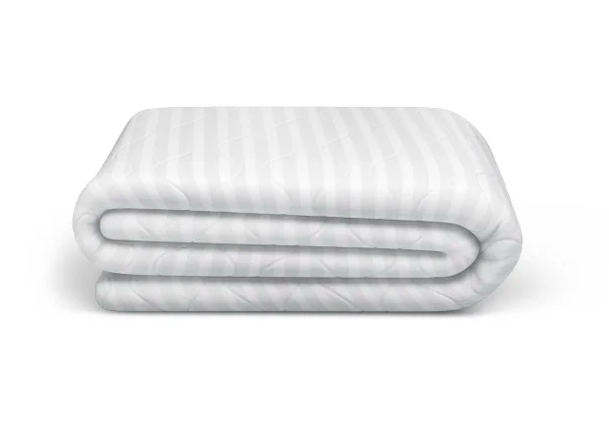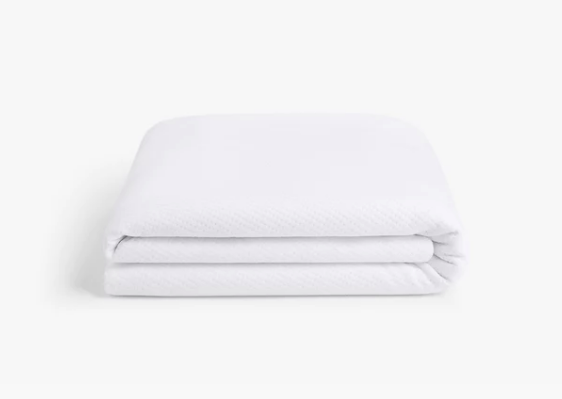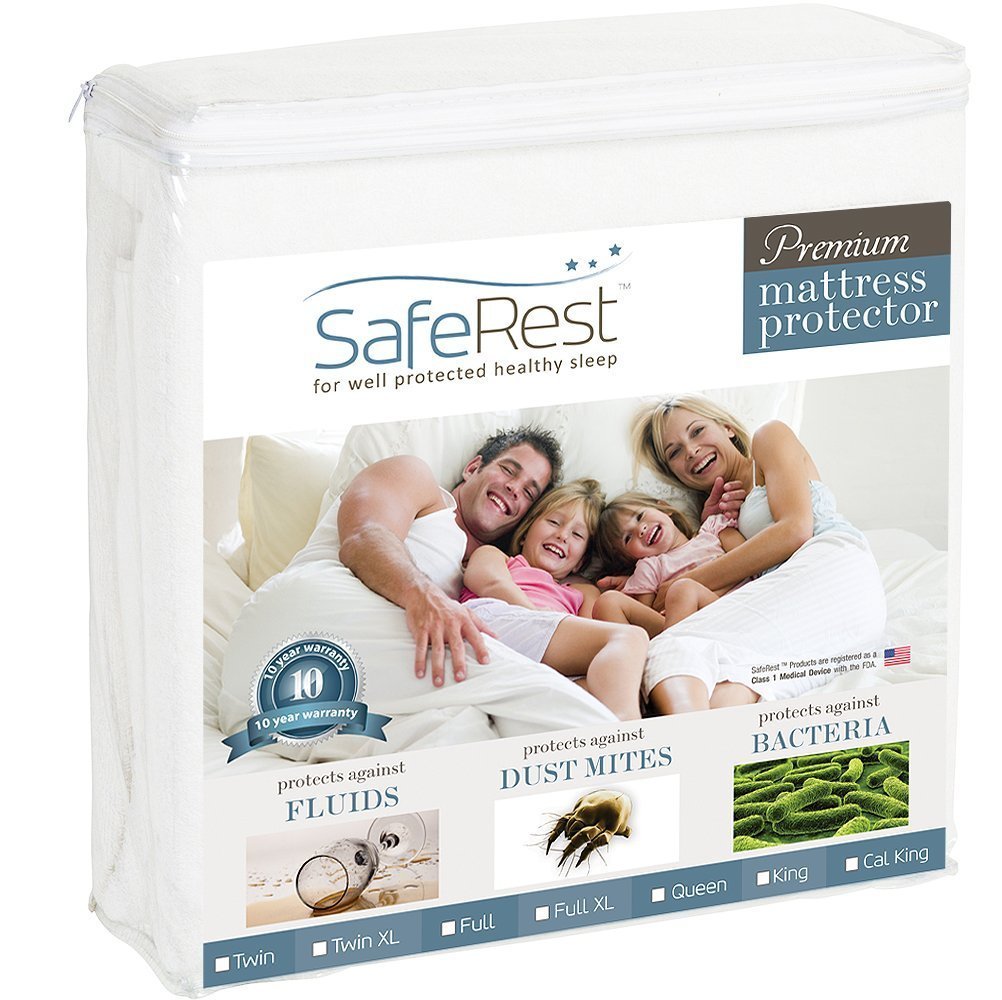Who Should Use a Mattress Protector?
People who can benefit from using a mattress protector include:
- Hot sleepers: Many people run hot while they sleep, causing them to sweat in bed. Over time, perspiration may stain your mattress cover. Moisture can also penetrate the surface and contaminate the bed’s internal layers, increasing the potential for mold growth.
- Parents of young children: Bedwetting is a common issue for young kids, particularly those age 7 or younger. A waterproof protector can safeguard a mattress against the permanent liquid damage that may occur after a nighttime accident. Most protectors are machine washable, making it easy to keep your child’s mattress hygienic after repeated bedwetting episodes.
- Pet owners: Most mattress covers can only be spot-cleaned, meaning that muddy paws and wet noses will easily leave permanent stains. Protectors are especially helpful if a dog, cat, or other critter naps on your bed during the day.
- Those with strong allergies: Dust mites and other allergens often reside on and inside mattresses, and removing them can be next to impossible. An effective protector will shield you from these allergens and stop new intruders from entering your sleep surface.
- People who live in humid places: Mold and bacteria tend to thrive in warm, balmy environs, leaving mattress owners in these locations vulnerable to mattress infestation. The same is true for people with windowless or otherwise dark bedrooms that are more likely to promote mold growth.
These examples highlight people who benefit most from using a protector, but realistically, every mattress owner should consider a protector for one simple reason: savings.
Virtually every mattress sold today is backed by a manufacturer’s warranty against structural and material defects. As part of the warranty agreement, the manufacturer will repair or replace any mattress with a recognized defect. In most cases, contamination issues as stains, liquid damage, mold, and infestations will all void your warranty.
A mattress protector can extend the lifespan of your mattress and potentially save you a great deal of money in the process.
Important Considerations for Mattress Protector Shoppers
Material and Feel
A good starting point for selecting a mattress protector is deciding which materials you like best (or least).
Traditional protectors made of vinyl have a slick, crinkly feel that many people find uncomfortable and unpleasant for sleeping. Another concern is safety, as some vinyls contain chemical additives known as phthalates that pose health risks. That said, vinyl protectors serve as excellent barriers against stains and moisture.
Protectors made of cotton, polyester, and other fabrics can be just as effective without the stiff feel. Most of these models have padded surfaces for a plush feel and side panels made of stretch jersey that offer decent elasticity. However, these protectors usually aren’t any more durable than their vinyl counterparts, but their sticker prices tend to be higher.
Liquid Protection
Waterproof protectors are the norm. Most protectors contain a thin polyurethane membrane that prevents liquid from seeping into the mattress. In recent years, some companies have unveiled protectors with waterproof membranes made of natural materials with liquid-absorbing properties such as wool, but these are much less common.
If you need a waterproof barrier for your mattress, be sure to scope out the product specs before choosing a protector. Some offer great absorbency but aren’t technically waterproof, which can spell doom for the mattress in the event of a heavy spill or bedwetting incident.
Coverage
Protectors often mimic the look and shape of a fitted bed sheet. They have elasticated corners to stretch snugly around the corners of your mattress and cover the sides. Anyone who needs a protector strictly for waterproofing their sleep surface will probably be content with one of these fitted models.
Encasement protectors fit snugly around the entire mattress with a zipper, buttons, locking mechanisms, or hook-and-eye closures. An encasement is considered the best method for staving off dust mites and bed bugs, both of which thrive inside mattresses and box springs. Five-sided protectors don’t shield the bottom, and are thus less effective at blocking these intruders.
Size and Depth
Today’s mattresses are widely available in six standard sizes: twin, twin XL, full, queen, king, and California king. Most protectors sold today match these sizes. Protectors designed for cribs or children’s mattresses are also fairly common, since many young kids wet the bed. Choosing the correct size not only ensures your mattress is adequately protected, but can also minimize uncomfortable bunching and stretching.
You should also take the profile of your mattress into account. Most mattresses measure 10 to 14 inches thick, and protectors sold today are designed to work within these parameters. If you choose a fitted protector, research the “pocket depth,” or the maximum mattress height the protector will accommodate. Full encasements also have thickness limitations to consider. When in doubt, reach out to the manufacturer for sizing and depth information.
Temperature Control
Lack of breathability is a common issue with mattress protectors. The waterproof polyurethane membranes often trap and retain body heat and prevent air from circulating between you and the mattress. This issue can be particularly bothersome with vinyl protectors, but even those composed of fabric can feel uncomfortably warm if they contain polyurethane.
Hot sleepers may find relief from protectors containing cotton, wool, and other natural fibers for their waterproof barrier. Some of today’s manufacturers integrate phase-change material and other cooling agents to help the protector resist heat buildup, but expect to pay more for these models.
Noise
Waterproof protectors with polyurethane membranes may produce rustling or squeaking sounds. Vinyl can also be somewhat loud, so these protectors carry the highest noise potential. Fabric protectors are rarely silent, but these models are less likely to disrupt your sleep.
Ease of Care
Consistently cleaning can ensure your protector stays hygienic and germ-free. The vast majority can be machine-washed and tumble-dried for quick and easy care, which is especially convenient for parents of bedwetting children and others who need to clean their protector more frequently.
However, laundering your protector will cause the materials to break down and deteriorate over time. The more often you clean the protector, the faster it will wear out.
Price
On average, a new, high-quality mattress protector costs between $50 and $175. Factors that influence the price-point include size, materials, waterproofing, and whether the protector is a fitted or full-encasement model.
One thing to keep in mind: protectors aren’t very durable. The relatively short lifespan of a protector may be reduced even further if you need to wash it more than once or twice a month. You may be tempted to invest in a more expensive protector in the hope it will last a long time – but realistically, expect a lifespan of two to three years for any protector regardless of its up-front cost, and even less time for one you need to frequently clean.
What Are the Differences Between Mattress Protectors, Pads, and Toppers?
Many companies that sell bedding products use the terms “protector” and “pad” interchangeably, and consumers also frequently conflate the two. Despite some structural and functional similarities, protectors and pads are two different products. Adding to the confusion are mattress toppers. Below, we’ve listed a few important distinctions between these three sleep accessories.




